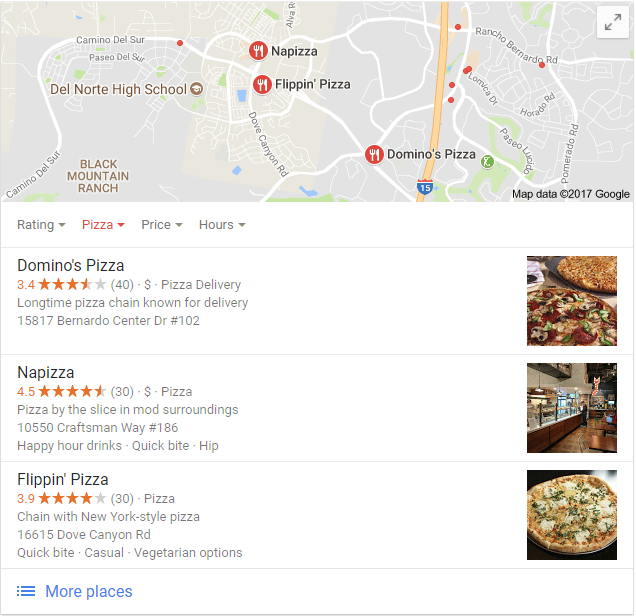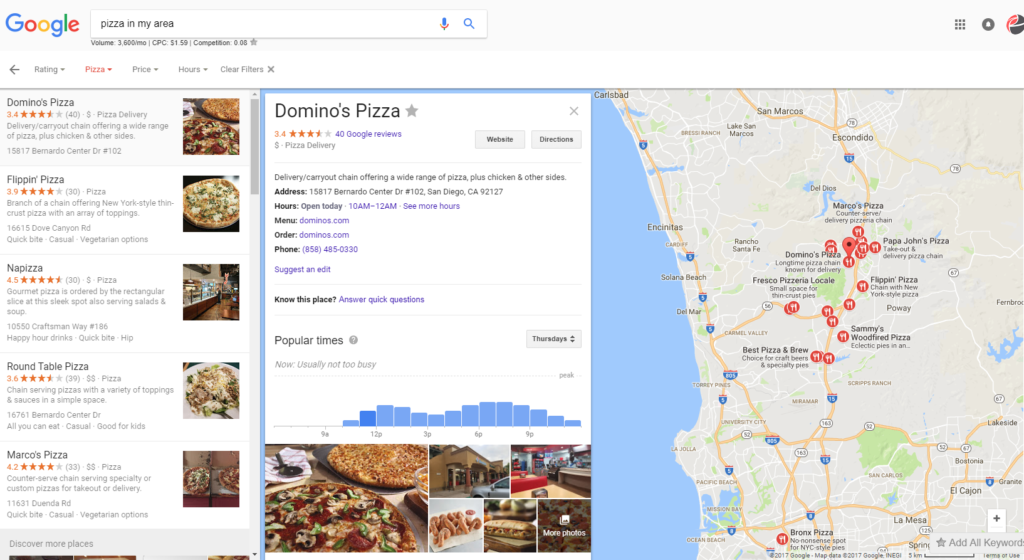Competing in the Modern World with Google My Business
For a long time, when you needed to find a business, you were very limited in your searching capabilities. Either you would hear about it from an advertisement or by word of mouth, or you’d have to physically search by driving or walking around your area. Of course, this took time and effort, and finding the perfect Sushi restaurant or a hardware store could be a daunting task. The actual searching process could be so much of a nuisance that you’d just end up at the first place you found without any prior knowledge of the business, or you’d just give up. This, of course, lead to a lot of unsatisfied consumers.
Once the Internet took over, there was a mad rush for businesses to establish an online presence so that consumers could easily find them. As Google and other search engines have refined their algorithms and interfaces, just being online isn’t enough anymore. It’s great if you have a website, but when Google compiles lists of billions of websites, you can easily become virtually invisible.
Think of Google like a new freeway that they built right through your town. Suddenly, businesses that are closer to the freeway are getting a lot more business than those further into town. Even if you have the best hamburger in the area, people are going to stop at Wendy’s because it’s right off the highway and they don’t know that there’s a much better option a few blocks over. In the past, you’d have to get a billboard or a radio advertisement to level the playing field. Now, there’s Google My Business for local listings.
A Brief History
Google My Business was officially introduced in June 2014, but it first came about in 2004 as Google Local, which was a smarter, more comprehensive version of Yellow Pages that included contact information as well as a simple map feature. Over the years, the service has gone through several iterations. It was rolled into Google Maps in 2005, then the service became a Maps feature called Google Places Pages in 2009. Reviews and user-generated content were introduced in 2010 under the Google Hotpot launch, which was then rolled into Google Places in 2011. Google Places became Google+ Local in 2012, making it easier for businesses to connect with their customers. Because of this change, businesses had the option of creating a Google+ Business page, which was a separate, more comprehensive listing, and a Google+ Local page, which placed emphasis on the business’s location in relation to the user.
Then, in 2014, Google combined the two options into one easy-to-use interface called Google My Business. This service allows businesses to provide all their information in a readily-available, easily-accessible format, and places emphasis on locality in relation to a user. Google My Business even pins these results in a separate window at the top of their search results page, so if you’re listed in Google My Business, you have a much, much higher chance of getting noticed by potential customers.
The Tools to Compete
Setting up a Google My Business is one of the most important things you can do to boost revenue for your business. It’s today’s phonebook, if phonebooks came with a billboard, a product catalogue, and a group of critics and peers raving about your business. Basically, it’s one of the best tools you have at your disposal. Just by setting one up, you’re putting yourself on a level playing field with every other business in your area.
A lot of our clients at Radd Interactive are small and medium-sized businesses. They don’t have the star power of a Walmart or an Amazon, so they’re competing for consumers with thousands of other businesses just like them. For these smaller companies, every detail counts. They win customers over through things like accessibility, succinct descriptions, and user-friendly interface. Even a bolded keyword in a meta description could make a customer click on your website instead of someone else’s. These details may seem insignificant, but put yourself in the consumer’s shoes for a moment.
It’s Saturday night, and you’re in the mood to go out for pizza and a beer. You turn on your laptop, go your preferred browser, and type “pizza in my area.” The search engine results will pull up millions upon millions of results, but you’re hungry and don’t have time to browse through all that, so you’re just focusing on the first page of results. You’ll notice that almost half the page is dominated by this window:

Now, you have information on three pizza restaurants. You know where they’re located, how highly they’re rated, how expensive they are, and you even have a few words or a brief description so that you know what to expect.
If you click on one of the results, you can get even more information:

Now you’re on a page that has a navigational list of local pizza restaurants on the left side of the screen. When you selected a result on the previous page, it brings up a small pop-up window that shows the name of the business, a short description, the address, business hours, websites, and phone number. It even has a chart to show what that store’s busiest times are. This pop-up window shows up for any of the businesses featured on the left-side navigational bar.
On the right-hand side is a Google Maps page that marks all the businesses on a map so that you can get a sense of how many choices you have in your area. Directly underneath the search bar, there’s a few drop-down menus that you can select.

These menus are for the customer to refine their search. Do you want a high-end pizza restaurant, or do you want to get the most pie you can get for your dollar? Do you want to sort by the highest rating? Do you want to go out for a late-night slice? Google My Business gives the customer a lot more options when searching for a business, both in how they search and the results that they get.
Of course, how much of this information is available is entirely dependent upon what the business owner provides on his or her Google My Business profile. It’s certainly easier for the customer if you have one though, isn’t it?
Setting Up Your Google My Business
Like anything, the amount positive results you see from your Google My Business listing is entirely dependent upon the amount of effort you put into it. Though it levels the playing field for small and mid-sized companies that lack brand recognition, Google My Business only shrinks the amount of competition from millions to dozens. Meaning, you still must compete with every other local business in your area. There are certain things you can do to ensure that you’re getting the most out of your Google My Business page.
Local Directories
Getting yourself listed in directory services is huge. If you have a listing on Yelp, TripAdvisor, or your town’s local business directory, Google will see that you have authority and a strong local presence and will rank your website higher in local listings because of this. Make sure you’re listing the same information across all platforms, as a discrepancy can tank your ranking.
Categorization
Another important thing to remember is proper categorization and tagging when you’re creating your Google My Business page. It may seem obvious, but businesses that only have a minimal amount of information on their Google My Business page are bound to stagnate in terms of rankings and enticing new customers. If you own a pizza restaurant, make sure you categorize your business as a restaurant that sells pizza. If you have a bar, include it. If you’re a hip and chic modern café that only does stone pies and specialty drinks, include it. Leave nothing out. It could be the deciding factor when a customer chooses the place across the street instead of your business. Sorry, they didn’t know you had vegan options.
Links
Building and establishing links across websites is extremely important in SEO, but it also can have a noticeable effect on your local search listing rank. If Google sees a bunch of links on sites with high authority that point to your website, then you’ll get ranked higher in local listings. This is one of the more intensive ranking factors, and it requires a lot of effort, but a few links from well-established websites can pay off in spades.
Social Media
Other intensive strategies include reviews and social media activity. There’s not much you can do about reviews beyond encouraging customers to write one, but if they do, having a few good reviews can have a very positive effect on your ranking. In the meantime, you can establish social media presence and encourage people to like, follow, or rate your business on whichever platform they prefer. Though these don’t factor directly into Google’s ranking algorithms, they can have a positive effect in that people are more likely to go to your business if it’s all over Facebook, Instagram, and Twitter. Having listings on these platforms helps establish your brand and makes your business more visible, and that’s never a bad thing.
Name and Location
Even your name and location can have a huge effect on your local listing rank. These may seem obvious, but sticking with the pizza example above, if you’re listed as “Gary’s Pizza,” instead of just “Gary’s,” you’re going to rank higher because Google can readily see what your business sells or does. Your location is just as important, though there’s not much you can do to change that beyond renting a new building.
Watch Your Business Grow
Google My Business is one of the most valuable tools that any business owner has at his or her disposal. It presents all your information in a readily-available, easily-accessible format so that customers will know who you are, what you do, where you’re located, and why they should choose you. It’s one of the easiest things you can do to compete with other local businesses, and with just a little bit of effort, you can boost your local listing to the top of the ranks.
Interested in taking your SEO campaign to the next level? Contact the SEO experts at Radd Interactive today to see how we can help you climb to the top of the search results.
